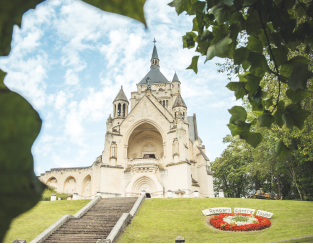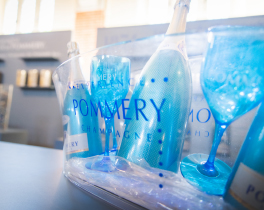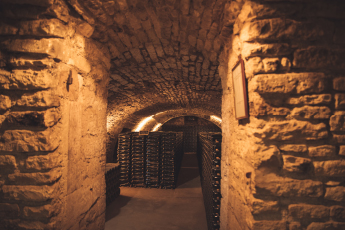Sipping Champagne in Champagne
Nectar of the Gods in the Land of Lovers

The Avenue de Champagne: Epicenter of Elegance.
Forget Gotham’s swank Park Avenue. Forget Monte Carlo’s Carré d’Or. If you wanted to wipe out most of the world’s veiled wealth in one fell swoop, the place to carry out your nefarious plan would be along the famed Avenue de Champagne in Épernay, France. Buried in a subterranean world some 125 feet beneath this elegant thoroughfare—just over a mile in length—lie, by many estimates, billions of dollars’ worth of the ambrosia of the gods: Champagne. Have flute, will travel.
Along this majestic boulevard are 18 maisons de Champagne, including the legendary Moët & Chandon, Perrier-Jouët, and Pol Roger, as well as lesser-known gems such as Champagne Esterlin (a cooperative) and Champagne A. Bergère.
Beneath the tranquil façade of 18th- and 19th- century mansions lies a sparkling labyrinth—over 200 million bottles of Champagne resting in nearly 70 miles of chalk caves (les crayères). This UNESCO World Heritage Site earned its designation in 2015. Over the years, the Avenue has gone by many names, each evoking luxury, indulgence, and prosperity. Today, locals simply call it “the AC.”
Here you can sip and savor in many of the maisons or take a tour and tasting (reservations recommended). For convenience, there’s an Office de Tourisme on the AC. Still, the Avenue is only one part of Champagne’s larger story. I chose to explore the greater region by car—some solo, and some under the expert guidance of Rémi Boxho, owner of Instants Champagne. Together, we indulged in the beauty, heritage, and sparkle of France’s Grand Est region, a new appellation combining the former territories of Alsace, Champagne-Ardenne, and Lorraine.
A Museum of Bubbles and History
A stop in Épernay that is de rigueur is the Musée du Vin de Champagne et Archéologie Régionale, housed in the Château de Perrier. The museum is home to some 80,000 objects, including one of France’s largest regional archaeological collections. Among its many treasures is a fascinating exhibit detailing how Champagne was produced in centuries past—a must for any oenophile or history lover.
Rémi, a natural bon vivant, seems to know everyone in “Champagneville.” Sensing my enthusiasm for tasting the various styles of Champagne, he quickly detoured from our set itinerary to include a few spontaneous stops. My original plan featured Lancelot Royer and Pierre Paillard, but we managed to “sandwich in” Henri Giraud, and as we neared Reims, the renowned Ruinart.
Though time was short at each cellar (it’s a shame to “drink and run”), every visit offered something unique—whether architectural splendor, artful presentation, or a singular tasting experience. At Pierre Paillard, we even hopped into a golf cart to tour the vineyards—an unforgettable way to view the source of such effervescence.
Medieval Charms and Modern Luxury
No visit to Champagne would be complete without exploring the medieval village of Troyes. Believed to date back to 600 BC, Troyes offers a vivid departure from the beige-on-ecru palette of typical French countryside towns. Here, colorful half-timbered houses line the streets in delightful contrast.

A visit to Maison Caffet for its ambrosial chocolates—boldly claiming “sans doute les meilleurs”—is non-negotiable. Then, dedicate half a day to the Cité du Vitrail, a museum devoted to the art and evolution of stained glass across ten centuries. Housed in the Hôtel-Dieu-le-Comte, it shares space with an extraordinary historical gem: an intact 18th-century pharmacy from 1725. Shelves are lined with nearly 300 decorative earthenware pots and another 300-plus painted wooden boxes that once held remedies, herbs, and botanical extracts—a fascinating window into the past.
For a divine interlude, I highly recommend lunch and a spa afternoon at The Royal Champagne Hotel & Spa in Champillon. Perched above the rolling vineyards, this architectural masterpiece seems to hug the mountainside. Each of its 47 suites opens to panoramic vineyard views. The wine list alone—more than 20 pages of Champagne offerings—will challenge even the most seasoned enthusiast.

Benedictine Legends and Village Views
Rémi treated me to a spectacular photo stop in Hautvillers, a UNESCO-listed village famed as the birthplace of Champagne. Here lies the Abbey of Saint-Pierre, final resting place of the Benedictine monk Dom Pérignon. While he didn’t technically invent Champagne, he refined its vinification process, laying the foundation for the sparkling perfection we enjoy today.
Hautvillers is rich with charming restaurants, but Rémi wisely chose Au 36, where the menu is designed around Champagne pairings. After lunch, consider a leisurely cruise on the Marne River—a tranquil finale to a day steeped in history and effervescence.
Reims: Grandeur and Grace
My journey concluded in Reims, home to the magnificent Cathédrale Notre-Dame de Reims, a UNESCO site and Gothic masterpiece. Nearby stands the elegant Bibliothèque Carnegie de Reims, a gift from philanthropist Andrew Carnegie. The city is also the headquarters of Champagne royalty: Veuve Clicquot, G. H. Mumm & Co., Pommery, and Taittinger all call Reims home.

I stayed at La Demeure des Sacres, a grand B&B owned and operated by the gracious Céline Songy, whose warmth and hospitality were unforgettable. For dinner, I walked five minutes to the Hôtel La Caserne Chanzy, housed in a former firehouse, now home to the Michelin-listed La Grande Georgette. With a view of the Cathédrale and cuisine as beautiful as it was delicious, it was a picture-perfect ending to an exquisite five days in the Grand Est.
In case you’re wondering, America imported nearly 27 million bottles of Champagne in 2024—proof that we’re a nation that knows how to toast in style. So whether you’re savoring a glass on the Avenue de Champagne or in your own living room, raise your flute to the timeless elegance and artistry of France’s most sparkling gift to the world. Alors, à votre santé!
Additional Information
Explore more: explore-grandest.com/en | atout-france.fr/en
Places to Stay (in addition to those above):
Troyes: La Licorne Hôtel & Spa — centrally located, elegant, and within walking distance of most attractions. Offers parking and a plentiful breakfast.
Vinay: La Briqueterie Hôtel & Spa — a bucolic retreat with fine amenities, excellent cuisine, and full spa services.
Bar-sur-Aube: Qualisterra Maison d’Hôtel & Vignoble — a family estate with personal hospitality and Champagne served in a tranquil courtyard.
Photos: Explore Grand Est, ©ART GE - Pierre Defontaine


 --
-- 

